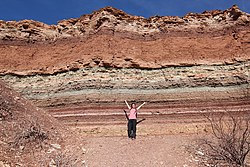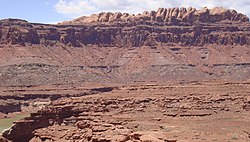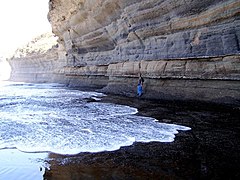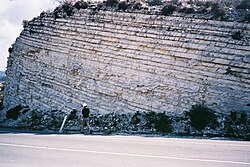Слој (геологија)


8.800 m (29.000 ft) дебљине у неким областима.
Слој је геолошко тело, изграђено од мање или више истоветног материјала. То је основни елемент седиментих стена, настао као резултат једне континуиране фазе седиментације, чији је првобитни положај хоризонталан или субхоризонталан.[1] Од подинског и повлатног слоја издвојен је површима слојевитости, које представљају границе механичког дисконтинуитета. Управно растојање између доње и горње површи слојевитости је дебљина слоја. Према дебљини, слојеви се деле на: лиске (испод 5 mm), плоче (од 5 до 50 mm), слојеве (5 до 60 cm) и банке (дебљина већа од 60 cm).
Слој је у простору одређен својим елементима пада, азимутом и падним углом. Врло је важно познавати елементе пада слоја, због одређивања елемената набора које слојеви изграђују. Тако је, у теренима који имају сложен тектонски склоп, важно одредити да ли су слојеви у преврнутом или нормалном положају. То се најчешће ради на основу испитивања карактеристика примарних планара, при чему се најчешће користе следећи критеријуми: биостратиграфско простирање, градациона слојевитост, критеријум односа кливажа према слојевитости, испитивање седиментних структура, анализа набора нижег реда, итд.[2]
Карактеристике[уреди | уреди извор]

Стратум је генерално један од низа паралелних слојева који леже један на другом и формирају огромне дебљине слојева.[1] Површине лежишта (равни лежишта) које раздвајају слојеве представљају епизодне прекиде у таложењу повезане или са периодичном ерозијом, престанком таложења или неком комбинацијом ова два.[3][4] Наслагани заједно са другим слојевима, појединачни слојеви могу формирати сложене стратиграфске јединице које се могу простирати на стотине хиљада квадратних километара Земљине површине. Појединачни слој може покрити сличне велике површине. Слојеви се обично посматрају као траке различитих боја или различито структурираног материјала изложене у литицама, усецима путева, каменоломима и обалама река. Појединачне траке могу варирати у дебљини од неколико милиметара до неколико метара или више. Трака може представљати специфичан начин таложења: речни муљ, песак на плажи, мочвара угља, пешчана дина, корито лаве итд.
Врсте стратума[уреди | уреди извор]
У проучавању слојева стена и седимената, геолози су препознали низ различитих типова слојева, укључујући корито, ток, траку и кључно лежиште.[1][5] Лежиште је један слој који се литолошки разликује од осталих слојева изнад и испод њега. У класификационој хијерархији седиментних литостратиграфских јединица, корито је најмања формална јединица. Међутим, само слојеви који су довољно карактеристични да буду корисни за стратиграфску корелацију и геолошко мапирање обично добијају формална имена и сматрају се формалним литостратиграфским јединицама. Вулкански еквивалент лежишта, ток, је дискретни екструзивни вулкански слој или тело које се разликује по текстури, саставу или другим објективним критеријумима. Као и у случају корита, ток треба означити и именовати као формалне литостратиграфске јединице само када је карактеристичан, распрострањен и користан за стратиграфску корелацију. Трака је танак слој који се разликује по специфичној литологији или боји и користан је у корелацији слојева. Коначно, кључно лежиште, које се такође назива и обележивач, је добро дефинисан, лако препознатљив слој или тело слојева који има довољно карактеристична својства, као што су литологија или фосилни садржај, да се препознају и корелирају током мапирања геолошког поља или подземне површине.[1][5]
Галерија[уреди | уреди извор]
-
Слојеви на планинској површини у француским Алпима
-
Слојеви стена у Депот Бичу, Нови Јужни Велс
-
Линија потањања Дугиног басена у формацији Барстов у близини Барстова, Калифорнија. Преклопљени слојеви.
-
Изданак горњег ордовицијанског кречњака и малих шкриљаца, централни Тенеси.
-
Слојеви креде на Кипру - приказују класичну слојевиту структуру.
-
Тешки минерали (тамни) као танки слојеви у кварцном песку на плажи (Ченеј, Индија).
Референце[уреди | уреди извор]
- ^ а б в г Salvador, A. ed., 1994. International stratigraphic guide: a guide to stratigraphic classification, terminology, and procedure. 2nd ed. Boulder, Colorado, The Geological Society of America, Inc., 215 pp. ISBN 978-0-8137-5216-7
- ^ Neuendorf, K.K.E., Mehl, Jr., J.P., and Jackson, J.A. , eds., 2005. Glossary of Geology 5th ed. Alexandria, Virginia, American Geological Institute. 779 pp. ISBN 0-922152-76-4
- ^ Davies, N.S., and Shillito, A.P. 2021, True substrates: the exceptional resolution and unexceptional preservation of deep time snapshots on bedding surfaces. Sedimentology. published online 22 May 2021, Davies, Neil S.; Shillito, Anthony P. (2021). „True substrates: The exceptional resolution and unexceptional preservation of deep time snapshots on bedding surfaces”. Sedimentology. 68 (7): 3307—3356. S2CID 236375915. doi:10.1111/sed.12900..
- ^ Davies, N.S., and Shillito, A.P. 2018, Incomplete but intricately detailed: the inevitable preservation of true substrates in a time-deficient stratigraphic record. Geology, 46, 679–682.
- ^ а б Murphy, MA., and Salvador, A., 1999. International stratigraphic guide—an abridged version. Episodes, 22(4), pp.255-272.
Литература[уреди | уреди извор]
- Neuendorf, K.K.E., J.P. Mehl, Jr., and J.A. Jackson, eds., 2005. Glossary of Geology (5th ed.). Alexandria, Virginia; American Geological Institute. p 61. ISBN 0-922152764
- Davies, Neil S.; Shillito, Anthony P. (2021). „True substrates: The exceptional resolution and unexceptional preservation of deep time snapshots on bedding surfaces”. Sedimentology. 68 (7): 3307—3356. S2CID 236375915. doi:10.1111/sed.12900..
- Campbell, Charles V. (фебруар 1967). „Lamina, Laminaset, Bed and Bedset”. Sedimentology. 8 (1): 7—26. Bibcode:1967Sedim...8....7C. doi:10.1111/j.1365-3091.1967.tb01301.x — преко Wiley Online Library.
- Reineck, H.E., and Singh, I.B., 1980. Depositional Sedimentary Environments, (2nd ed.) Berlin, Germany: Springer-Verlag, 504 pp. ISBN 978-3642962912
- McKee, Edwin D.; Weir, Gordon W. (1953). „Terminology for Stratification and Cross-Stratification in Sedimentary Rock”. Bulletin of the Geological Society of America. Geological Society of America. 64 (4): 381—390. Bibcode:1953GSAB...64..381M. doi:10.1130/0016-7606(1953)64[381:TFSACI]2.0.CO;2 — преко GeoScienceWorld.
- Collinson, J., and Mountney, N., 2019. Sedimentary Structures, (4th ed.) Edinburgh, Scotland, Dunedin Academic Press, 320 pp. ISBN 978-1903544198
- Miall, A.D., 2016. Stratigraphy: A Modern Synthesis. Dordrecht, Netherlands: Springer. 454 pp. ISBN 978-3319243023
- Boggs, Jr., Sam (2006). Principles of Sedimentology and Stratigraphy (PDF) (4th изд.). Upper Saddle River, NJ: Prentice Hall. ISBN 0-13-154728-3. Архивирано из оригинала (PDF) 05. 03. 2022. г. Приступљено 25. 06. 2022.
- Flügel, E. and Munnecke, A., 2010. Microfacies of carbonate rocks: analysis, interpretation and application. Berlin, Germany, Springer-Verlag, 2004 pp. ISBN 978-3662499610
- Lumsden, D.N., 1971. Facies and bed thickness distributions of limestones. Journal of Sedimentary Research, 41(2), pp.593-598.
- Ingram, R.L., 1954. Terminology for the thickness of stratification and parting units in sedimentary rocks. Geological Society of America Bulletin, 65(9), pp. 937-938.
- Kelley, V.C., 1956. Thickness of strata. Journal of Sedimentary Research, 26(4), pp.289-300.
- Australian Standards, 1993. Geotechnical site investigations. AS1726 – 1993. Sydney, Australia: Standards Association of Australia, 40 pp.
- International Organization for Standardization, 2017. 14689:2017 Geotechnical investigation and testing — Identification, description and classification of rock. Geneva, Switzerland: International Organization for Standardization. 122 pp.
- British Standards Institution, 2015. BS 5930:2015 Code of practice for ground investigations. London, England: British Standards Institution. 317 pp. ISBN 978-0580800627
- Tucker, Maurice, E. 1982. The Field Description of Sedimentary Rocks. Geological Society of London Handbook, Open University Press, Milton Keynes, UK, and John Wiley & Sons, NY. Table 5.2, p. 48.
- Murphy, M.A., and Salvador, A., 1999. International stratigraphic guide—an abridged version. Episodes. 22(4), pp.255-272.
- Steno, Nicolaus (1671). The Prodromus to a Dissertation Concerning Solids Naturally Contained within Solids: Laying a Foundation for the Rendering a Rational Attempt both of the Frame and the several Changes of the Masse of the Earth, as also of the various Productions in the same. Превод: Oldenburg, Henry (2nd изд.). London: F. Winter — преко Biodiversity Heritage Library.
- Levin, Harold L. (2009). The Earth Through Time. John Wiley & Sons, Inc. стр. 15. ISBN 978-0-470-38774-0.
- Kipfer, Barbara Ann. „Horizon”. Archaeology Wordsmith. Архивирано из оригинала 11. 1. 2018. г. Приступљено 2016-04-22.
- Pool, Christopher A. (2007). Olmec Archaeology and Early Mesoamerica. Cambridge: Cambridge University Press. ISBN 978-0-521-78882-3.
- David W. Anthony (2007). „How to Reconstruct a Dead Culture”. The Horse, the Wheel, and Language: How Bronze-Age Riders from the Eurasian Steppes Shaped the Modern World. Princeton University Press. стр. 131—. ISBN 978-0-691-05887-0. Приступљено 21. 10. 2011.
- Frank, Adams Dawson (1938). The Birth and Development of the Geological Sciences. Baltimore: The Williams & Wilkins Company.
- Ghosh, S.K. (1993). Structural geology : fundamentals and modern developments (1st изд.). Pergamon Press. ISBN 0-08-041879-1.
- Blatt, H.; Tracy, R.J. & Owens, B.E.; 2006: Petrology, Igneous, Sedimentary, and Metamorphic, W.H. Freeman & company, New York (3rd ed.), ISBN 978-0-7167-3743-8.
- Mathur S.M. (2008). Elements of Geology. PHI Learning Pvt. стр. 129—130. ISBN 978-8120335158.
- Brookfield M.E. (2008). Principles of Stratigraphy. John Wiley & Sons. стр. 200. ISBN 978-0470693223.
- 2004 North American Commission on Stratigraphic Nomenclature (2005). „North American Stratigraphic Code” (PDF). American Association of Petroleum Geologists Bulletin. 89 (11): 1567—1570. Приступљено 13. 6. 2020. „The wedge-out of a component formation or formations may justify the reduction of a group to formation rank, retaining the same name.”
- „Chapter 5. Lithostratigraphic Units”. International Commission on Stratigraphy. 2013—2014. Приступљено 4. 6. 2014.
- Thierry J.; Galeotti S. (2008). „Biostratigraphy from taxon to biozones and biozonal schemes”. Ур.: Rey J.; Galeotti S. Stratigraphy: Terminology and Practice. Editions OPHRYS. стр. 64—73. ISBN 9782710809104.
- „Chapter 7. Biostratigraphic Units”. International Commission on Stratigraphy. 2013—2014. Приступљено 4. 6. 2014.
- Cohen, K.M.; Finney, S.C.; Gibbard, P.L.; Fan, J.-X. (2013). „International Chronostratigraphic Chart 2013” (PDF). stratigraphy.org. ICS. Приступљено 15. 6. 2014.
- Harshbarger, J.W.; Repenning, C.A.; Irwin, J.H. (1957). „Stratigraphy of the uppermost Triassic and the Jurassic rocks of the Navajo country”. U.S. Geological Survey Professional Paper. 291. S2CID 32010827. doi:10.3133/pp291.
- Jones, James V., III; Daniel, Christopher G.; Frei, Dirk; Thrane, Kristine (2011). „Revised regional correlations and tectonic implications of Paleoproterozoic and Mesoproterozoic metasedimentary rocks in northern New Mexico, USA: New findings from detrital zircon studies of the Hondo Group, Vadito Group, and Marqueñas Formation”. Geosphere. 7 (4): 974—991. doi:10.1130/GES00614.1
 .
. - North American Commission on Stratigraphic Nomenclature (новембар 2005). „North American Stratigraphic Code” (PDF). AAPG Bulletin. 89 (11): 1547—1591. Bibcode:2005BAAPG..89.1547.. doi:10.1306/07050504129. Приступљено 8. 8. 2020.
- Ogg, James G.; Gradstein, Felix M.; Smith, Alan Gilbert (2004). A geologic time scale 2004. Cambridge, UK: Cambridge University Press. ISBN 9780521786737. Приступљено 26. 10. 2020.
- Peterson, Fred; Pipiringos, G.N. (1979). „Stratigraphic relationships of the Navajo Sandstone to Middle Jurassic formations in parts of southern Utah and northern Arizona”. USGS Professional Paper. 1035-B: B1—B43. doi:10.3133/pp1035B
 .
.








